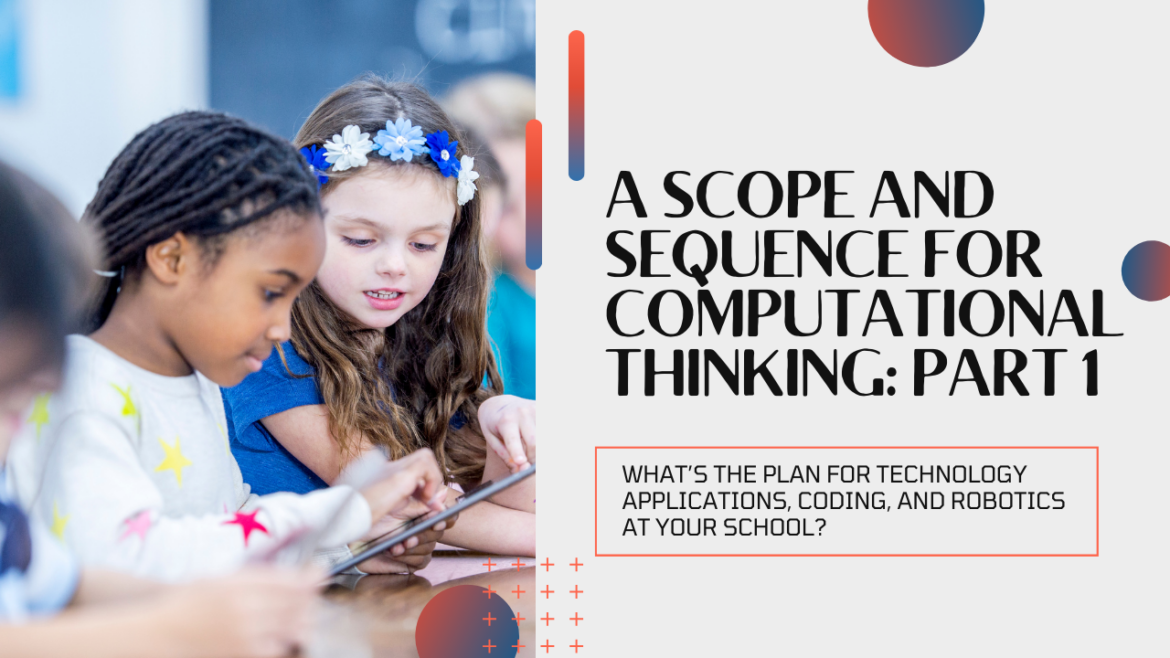“What’s your vision for a coding curriculum?” I asked a small private school. They had collected technology but lacked a real plan. What was missing? A clear scope and sequence showing when they should introduce certain technology and an alignment with computational thinking standards. Let’s explore a potential solution.
Defining Scope and Sequence
Many schools have a complex series of scopes and sequences to cover various topics and content areas. “Scope” means the topics covered. “Sequence” is the teaching order. The aim is to build on previous lessons, including a certain level of repetition and review, then add on to these concepts and introduce new ones. In this way, students add to their knowledge with each lesson in a spiraling curriculum. This allows for a recursive review of key concepts, skills, or themes.
The iterative learning cycle is a process children use to master new skills like walking, feeding themselves, reading, and more. The cycle involves making an attempt, failing, evaluating what went wrong, refining the approach, and starting the cycle again. This process values failure and self-assessment.
Source: The Iterative Learning Cycle
The Benefits of Iteration
What is iteration? Repetition. The opportunity to revisit and review content is well-supported. The use of high-effect size instructional strategies can enhance learning. Iteration also facilitates long-term information retention. You may be wondering what instructional strategies get the job done. The ones below are well worth pairing with curricular standards and technology:
- Retrieval Practice (d=0.49). A well-established strategy that increases access to retrieving “to-be-remembered” information. Entry and/or exit tickets and dice debriefs work well (source). This is also known as “practice testing” or “test-enhanced learning.”
- Rehearsal (d=0.71). This is the repetition or organization of information that has entered short-term memory (source). It relies on images, photographs, or index cards and involves memorizing information through repetition.
- Interleaved Practice (d=0.46). Implement a schedule of practice that mixes different kinds of problems. This strategy relies on a schedule of study that mixes different kinds of material within a single study session (source).
- Spaced vs Massed Practice (d=0.65). This strategy involves implementing a schedule of practice that spreads out study activities over time (a.k.a. distributed practice).
As you might imagine, a strategy like Teacher Clarity (d=0.85) is also helpful. It is helpful because it sets the expectation for what students will learn. It does this through three questions students can answer in their own words:
- Set the learning intention. Ask, “What am I learning?”
- Explore the relevance. Ask, “Why am I learning it?”
- Specify success criteria. Ask, “How will I know I learned it?”
Strategies like the Engineering Design Process (EDP) and Design Thinking are also beneficial. These have the potential to accelerate student achievement. You can group EDP and Design Thinking as Explicit Teaching Strategies (d=0.63). That is, as follows:
Explicit teaching is like building with scaffolds. It guides students with clear goals and reasons for learning new skills. Teachers show and explain the target. Then, they support practice with feedback until the student masters it. This strategy involves direct instruction, guided practice, and teaching until mastery.
A “discovery approach” isn’t as effective as Explicit Teaching Strategies. The latter gets better results, especially when one combines the previously mentioned strategies.
Getting Started with a Scope and Sequence
Thanks to the power of AI, generating a starting point for a scope and sequence need not be onerous. In a long prompt, I specified a variety of high-effect size strategies (those discussed above) as well as ISTE standards. The product yields a basic scope and sequence that addresses the needs of a specific school. The long prompt was edited interactively in a chat with ChatGPT 4.0 and other tools, yielding the following results.
| Grade Level | Focus Area | Tools & Languages | ISTE Standards Alignment | Scope & Sequence |
|---|---|---|---|---|
| K-2 | Introduction to Coding | Scratch Jr., Sphero, Dash-n-Dot, SPIKE Essential | Computational Thinker | Begin with basic block coding concepts, incorporating retrieval practices like entry/exit tickets. Introduce storytelling, simple animations, and tactile interactions with Sphero, Dash-n-Dot, and SPIKE Essential for engaging robotics experiences. Use images and index cards for rehearsal. Activities are designed with teacher clarity and interleaved practice in mind. |
| 3-5 | Building Computational Thinking | Scratch, Micro:bit, SPIKE PRIME | Computational Thinker | Progress to more complex block coding and introductory text-based coding. Incorporate basic and more advanced robotics with SPIKE PRIME, emphasizing the engineering design process. Projects are sequenced using spaced practice, and concepts are revisited to deepen understanding. Teacher clarity is maintained with explicit learning goals and success criteria for each project. |
| 6-8 | Applied Coding & Robotics | Python, Swift, JavaScript, TinkerCAD | Computational Thinker | Focus on text-based coding, app and game development, and an introduction to advanced robotics concepts and design thinking challenges. Implement spaced and interleaved practices to tackle coding and robotics problems. Continue with explicit teaching strategies, ensuring students understand the relevance and application of their projects in real-world contexts. |
In part 2 of this blog series, you will see more specific ideas that explore K-2, 3-5, and 6-8 use of coding and robotics. We will also look into specific teacher clarity questions and more examples. Stay tuned!

